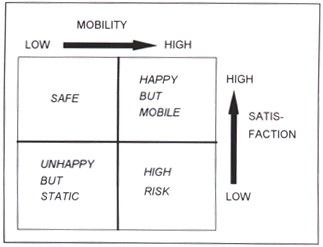A common paradigm that has emerged from the TQM movement is that the ultimate path to retaining customers is to satisfy their needs. The theory holds that by identifying what customers expect, and then meeting and exceeding these expectations, customers will be far less likely to seek the services of competitors.
Over the past few years, our analyses of different satisfaction data bases have validated this theory. We have found that customer satisfaction is indeed a strong correlate of retention and loyalty.
However, we have also found that the level of satisfaction with a service does not completely explain loyalty. In one study of a mass market service, we discovered that when all the effects of satisfaction were controlled, the strongest predictor of brand loyalty became the number of years the customer had used their current brand.
The analysis suggested a new hypothesis about customer retention: some customers will not change their brand of service even if they are dissatisfied, while others will switch or try new alternatives even when they are completely satisfied.
Other more comprehensive analyses of the determinants of loyalty and retention have suggested several factors, beyond satisfaction, that drive retention. These include:
- Past behavior
- Attitudes about purchasing, such as openness to new services
- Perceptions about the loss or gain of switching brands
- Demographics
In some cases, a company’s high customer attrition rate may have as much to do with the type of customer as with the quality of service. Such companies may rely heavily on aggressive marketing. Customers who are responsive to solicitation are also more likely to be brand switchers.
To help our clients more intelligently manage their customer retention, Rockbridge has developed scales to measure two constructs that together more fully explain loyalty — satisfaction and mobility. Existing customer satisfaction surveys often contain enough information to develop both of these measures. The satisfaction and mobility scales have a great deal of independence, meaning that a person who is “highly satisfied” can be either “highly mobile” (i.e., willing to switch to a competitor) or “static” (i.e., unlikely to change brands).
Customers can be classified by where they fall on each of the two characteristics:
- “Safe” customers are considered such because they are not only satisfied, but tend not to change services even when their satisfaction drops.
- “High risk” customers are both unhappy and more likely than other customers to move on; management might consider writing off this segment, since even if they could be satisfied, they would still be prone to leaving.
- Attention needs to be focused on the “unhappy but static” customers. Every company has customers like these. Whether it is due to laziness or fear of inertia, they are likely to remain customers despite their lower satisfaction. Companies should still seek to correct these customers’ problems. Even though their odds of leaving are less, they may still change brands, and a satisfied relationship will move them into the “safe zone.”
- “Happy but mobile” customers are satisfied, but are in danger of switching brands, perhaps because they like to shop for new deals or are receptive to marketing pressure. The strategy for retaining these types of customers is akin to “watching the chickens in the henhouse.” They need to be monitored more closely for switching cues. Companies should also structure pricing and programs to make sticking around economically rewarding.
Customer retention depends on much more than a process of continually improving satisfaction. It also requires dealing with attrition as an environmental circumstance that occurs even when the best service is in place.

